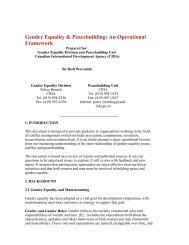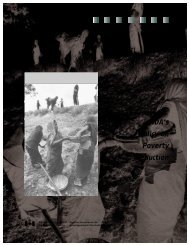Concepts and practices in agricultural extension in developing ...
Concepts and practices in agricultural extension in developing ...
Concepts and practices in agricultural extension in developing ...
- No tags were found...
Create successful ePaper yourself
Turn your PDF publications into a flip-book with our unique Google optimized e-Paper software.
Accord<strong>in</strong>g to Farr<strong>in</strong>gton (1994), a network with a sectoral (e.g. agriculture), or subsectoral (e.g. irrigationor crop process<strong>in</strong>g) m<strong>and</strong>ate generally operates more closely with ultimate beneficiaries (such as thosederiv<strong>in</strong>g livelihoods from agriculture) than those concerned with generic or cross-cutt<strong>in</strong>g themes suchas methods of <strong>agricultural</strong> research or <strong>extension</strong>.Every network arises <strong>in</strong> response to a unique set of circumstances: the challenges it proposes to address,the organizations <strong>and</strong> <strong>in</strong>dividuals available <strong>and</strong> <strong>in</strong>terested <strong>in</strong> work<strong>in</strong>g together <strong>and</strong> the resourcesavailable to support the work. The five major elements of network performance <strong>and</strong> related <strong>in</strong>dicatorsof success as <strong>in</strong>dicated by Creech <strong>and</strong> Ramji (2004) <strong>in</strong>cludes effectiveness, structure <strong>and</strong> governance,efficiency, resources, <strong>and</strong> susta<strong>in</strong>ability <strong>and</strong> life cycle. Some of the most common methodologies(Willard 2001) to assess the impact of network are:• SWOT analysis (strengths, weaknesses, opportunities, threats)• results-based management• logical framework analysis• outcome mapp<strong>in</strong>g• appreciative <strong>in</strong>quiry.In network<strong>in</strong>g <strong>and</strong> partnership, the comb<strong>in</strong>ed strengths <strong>and</strong> skills enable <strong>in</strong>dividual entities <strong>and</strong> societyto function more effectively <strong>and</strong> successfully. The ma<strong>in</strong> motivation is to maximize mutual benefitson issues of common <strong>in</strong>terest. Furthermore, partnerships should be seen as a means for generat<strong>in</strong>g<strong>in</strong>novation <strong>and</strong> not as an end <strong>in</strong> itself.1.3.7 Rural livelihoods 4Poverty is multidimensional, it goes beyond <strong>in</strong>come <strong>and</strong> <strong>in</strong>cludes vulnerability <strong>and</strong> lack of voice.The poor have assets on which they can draw (<strong>and</strong> which they can build up), they can use to pursuemultiple livelihood strategies <strong>and</strong> outcomes, often by manag<strong>in</strong>g a portfolio of part-time activities. Thepoor generally have limited entitlements, are commonly deprived of those they do have, <strong>and</strong> have<strong>in</strong>adequate <strong>in</strong>formation, knowledge <strong>and</strong> power to claim them.The Susta<strong>in</strong>able Livelihoods (SL) framework argues that the poor have assets <strong>and</strong> choices; developmentis not merely about <strong>in</strong>creas<strong>in</strong>g <strong>in</strong>come, but about broaden<strong>in</strong>g livelihood-related choices. In its broadestconception, the purpose of <strong>extension</strong> is to help <strong>in</strong> broaden<strong>in</strong>g choice. It is clear that the very poorestare unable to engage <strong>in</strong> production <strong>and</strong> even if they do; they are producers, consumers <strong>and</strong> labourersat the same time. Hence, they cannot be helped by <strong>agricultural</strong> <strong>extension</strong> directly. Here social policywill take on a more important role, <strong>in</strong>corporat<strong>in</strong>g livelihood <strong>extension</strong> <strong>and</strong> safety nets.Susta<strong>in</strong>able livelihood approaches identify the current livelihood strategies <strong>and</strong> objectives of thepoor, <strong>in</strong> the context of vulnerability, the <strong>in</strong>fluence of policies, <strong>in</strong>stitutions <strong>and</strong> processes <strong>and</strong> currentlevels of access to assets <strong>and</strong> entitlements. Accord<strong>in</strong>g to Christoplos et al. (2001), poor producersface high transaction costs due to limited <strong>in</strong>formation <strong>and</strong> weak <strong>in</strong>frastructure to access markets, newquality st<strong>and</strong>ards which may be unatta<strong>in</strong>able, <strong>and</strong> grow<strong>in</strong>g <strong>in</strong>stability as major purchasers (such assupermarkets) shift bulk purchases from one country (or cont<strong>in</strong>ent) to another <strong>in</strong> response to short-termmarket fluctuations. This stresses that the poor draw on a range of assets, which they either own or canaccess, <strong>in</strong> order to achieve a range of livelihood outcomes (go<strong>in</strong>g beyond <strong>in</strong>come to <strong>in</strong>clude greater wellbe<strong>in</strong>g,<strong>in</strong>creased voice <strong>and</strong> reduced vulnerability). To do so, they pursue a range of livelihood strategies,4. This section is heavily drawn from Christoplos et al. (2001).19





